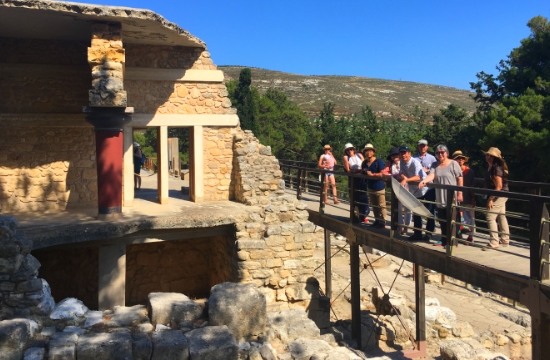An archaeologist with a lot of… imagination
Knossos: 125 years since the excavations of Arthur Evans

Heinrich Schliemann, the man who revealed the secrets of Troy, preferred to continue his research in the Hellespont rather than start a major excavation site in Crete, with an uncertain outcome. This does not, of course, negate the fact that the island had piqued his interest. And the famous archaeologist suspected that somewhere above Heraklion, he might find the legendary palace of the mythical king Minos.
However, the local merchant and antiquarian Minos Kalokairinos had secured the rights to the plot where Knossos was located, and during the excavations he carried out on the site, he discovered two palace storerooms. Kalokairinos was asking for 100,000 gold francs for the rights, and even the 40,000 francs that the Herakleian merchant offered after hard bargaining was too much for Schliemann. And so another archaeologist seized the opportunity: the British Arthur Evans.
Evans, a museum director from Oxford and an admirer of Schliemann, believed in the excavations of Knossos, as well as in the limited findings that had emerged from Kalokairinos’ work up to that point. From 1895, he gradually began to acquire an ever-larger part of the site, and on March 23, 1900, 125 years ago, he began his excavations with a crew of initially 30 workers, which over time increased to 100.
Gradually, the ruins of a large palace over 3,500 years old were uncovered. In them, Evans saw the city-state of Knossos and King Minos, as described by Homer. The excavations revealed many residential and storage buildings, which were connected by stairs and corridors, the supposed apartments of the king and queen of Knossos, as well as the large central courtyard of the palace.
An archaeologist with a lot of… imagination
The problem was, however, that during the work, Evans trusted too much… his imagination, giving his own interpretations of what exactly the findings were – and this not only in frescoes of which he had only a small part in his hands, but even in entire buildings. If he found, for example, an alabaster chair in a building, then he decided rather arbitrarily that it was the “throne room”. However, in many cases, he may have been completely wrong in his assessments.
Evans carried out many reconstructions in the Knossos area, acting with complete artistic freedom and creating structures first from wood and later mainly from cement. Thus, visitors to the site enter a Minoan “Disneyland”, experiencing an impressive experience in the palaces. For today's researchers, however, Evans' reconstructions have proven to be a major problem, because it is now impossible to draw independent conclusions about the buildings of the site and therefore we will probably never know what the real purpose of each of the buildings of Knossos was.
The history of the palace
What has been established with certainty, however, is the distinction between two palaces that were built on the site: the first must have been built after 2100 BC and was destroyed around 1700 BC by an earthquake, while the new Minoan palace must have been built around 1450 BC and was destroyed by fire about a hundred years later – the destruction of the palace coincides with the end of the Minoan civilization in Crete and with it the Bronze Age.
Another disadvantage of Knossos is the separation between the archaeological site and the archaeological finds. Apart from a few replicas of finds inside, the palace is completely empty. The many and mostly extremely impressive finds are in the Archaeological Museum of Heraklion, which is definitely worth a visit. However, the way they are displayed prevents the visitor from admiring them in their “natural” environment, where they were found in antiquity.
In 1911, Arthur Evans was knighted for his contribution to archaeology. Thirty years later, on July 11, 1941, the famous archaeologist breathed his last at the age of 90.
Source: DW




Comments
Post a Comment
leave a message please